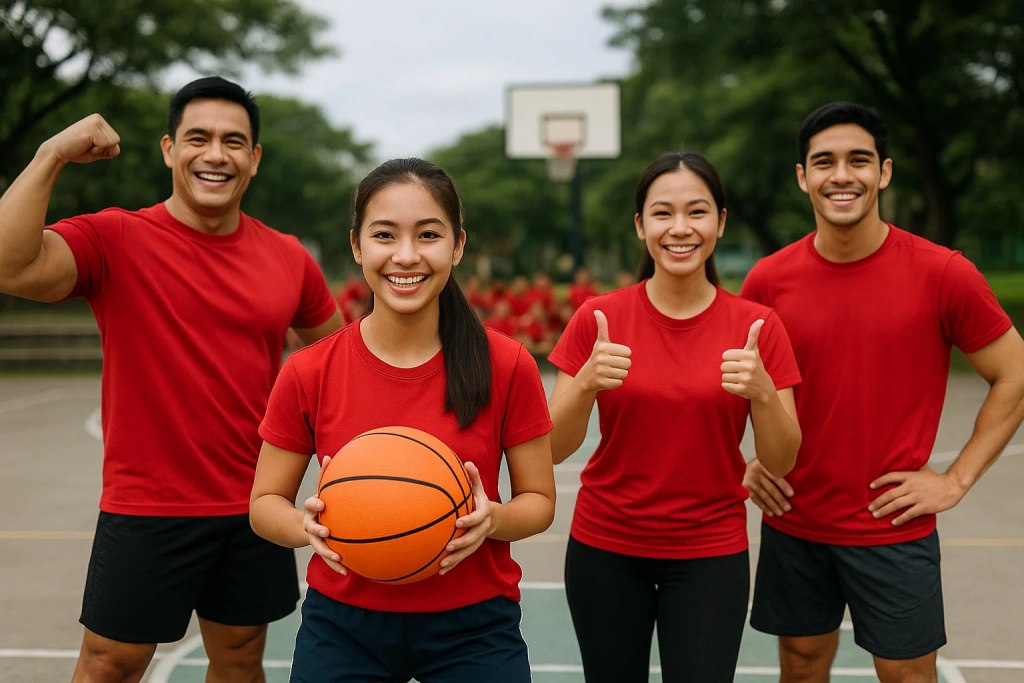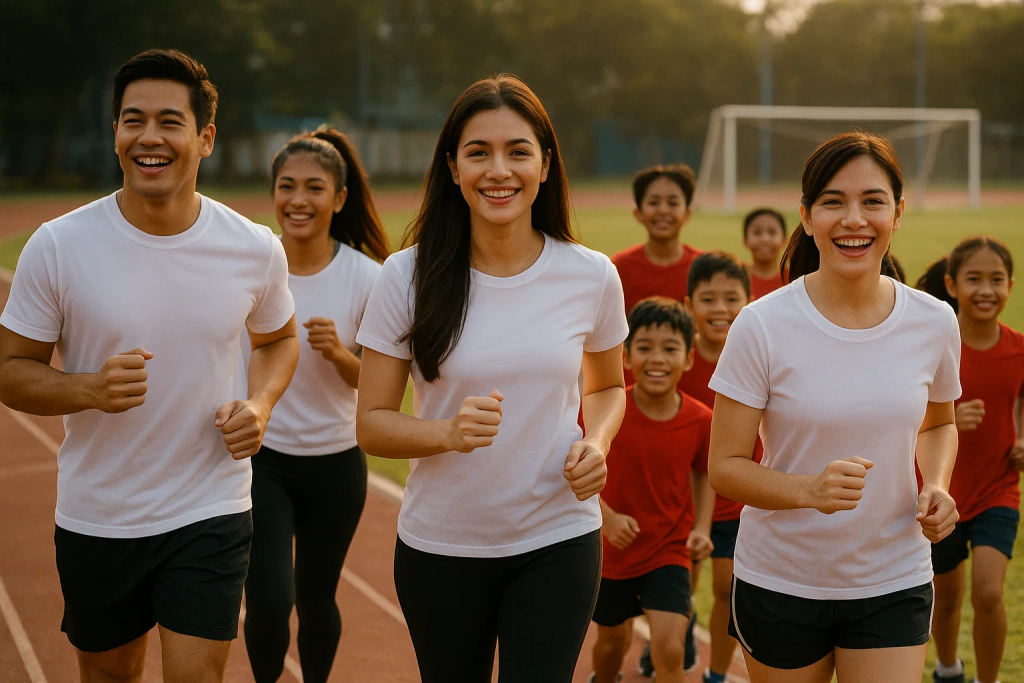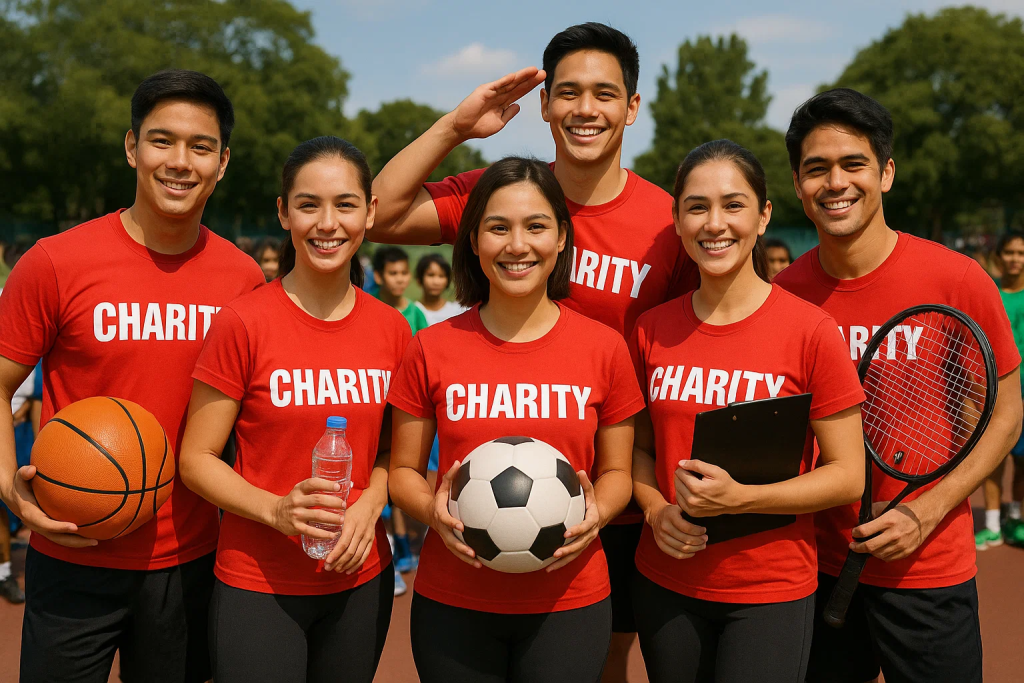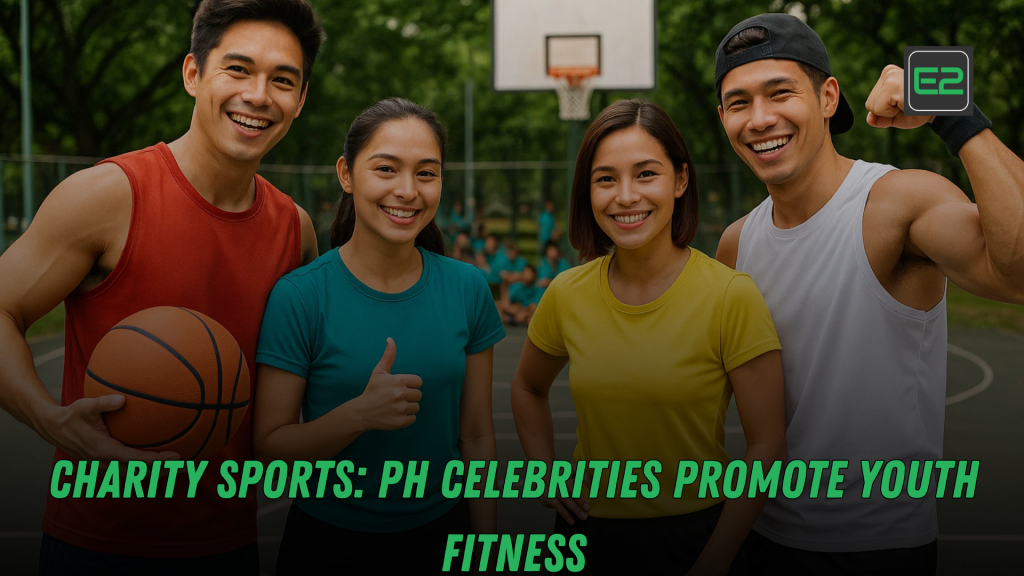Table of Contents
Executive Summary (TL;DR)
- Why this matters: Over 81% of adolescents worldwide don’t meet WHO’s daily physical activity recommendations, with Filipino kids and teens seeing rising rates of overweight and obesity—a trend UNICEF calls out as alarming.
- What’s working: Celebrity-led charity sports—from Anne Curtis’s UNICEF runs to Piolo Pascual’s SunPIOLOgy, Sun Life’s 3×3 Charity Challenge, Alden Richards & Barbie Forteza’s recent fun runs, Alyssa Valdez’s youth volleyball camps, Tzu Chi’s Charity Run, and Manny Pacquiao’s grassroots leagues—are combining star power + community events to raise funds, build facilities, and get kids moving.
- The opportunity: Use this momentum to scale school- and city-level programs, tie in with Palarong Pambansa (which added weightlifting as a demo sport in 2025), and standardize activation models that schools, LGUs, brands, and NGOs can replicate.

The Bigger Picture: Why Charity Sports Are a High-Impact Play for Youth Health
Physical charity activity is a protective factor for cardiometabolic health, mental well-being, and academic performance. But the global reality is stark: 81% of adolescents (11–17) are not active enough, with girls less active than boys.
In the Philippines, multiple datasets show a worrying rise in overweight and obesity among children and adolescents. UNICEF’s 2024 country updates estimate 12.9% of children aged 5–10 and 12.5% of those 10–19 are overweight/obese, trends that have moved upward since earlier ENNS rounds. UNICEF’s 2025 global briefing further warns that childhood obesity has now overtaken underweight in most regions.
At the same time, local research (UP Diliman / AHK Philippines) graded our youth’s physical activity poor to middling and helped inform DOH’s National Health Objectives 2023–2028—a sign that policy is ready to respond if communities mobilize.
Bottom line: The Philippines needs visible, trusted catalysts that make movement exciting and accessible to kids. That’s where celebrity-driven charity sports shine: they attract families, unlock sponsors, earn media, and normalize active lifestyles.
PH Charity Celebrities Turning Fitness Into a Force for Good
Anne Curtis: From “Happiest 5K” to Marathon Fundraisers
- The Color Run Dream (2017, Manila) raised ₱7.5 million for UNICEF’s children with disabilities program—an iconic blend of fun culture and inclusive advocacy.
- Tokyo Marathon (2023): Anne ran a 42.2 km fundraiser for child protection work with UNICEF, contributing ₱1–2+ million based on multiple local reports and her public pledge to match donations.
Why it works: A beloved celebrity + a joyful, family-friendly format lowers the barrier for first-time participants and converts spectators into fundraisers.
Piolo Pascual & Sun Life: A Decade of SunPIOLOgy
- SunPIOLOgy virtual race (2020/2021) raised ₱4.2 million for health and education programs (Hebreo Foundation scholars, diabetes awareness).
- Earlier runs (e.g., 2018) topped ₱5 million, showing long-term consistency.
- The ecosystem now includes Sun Life Cycle PH—broadening appeal beyond running.
Why it works: Program continuity + consistent branding + multi-sport formats = repeat donors and wider youth engagement.
Sun Life’s 3×3 Charity Challenge: Courts, Community, and Culture
- In August 2023, Sun Life staged a 3×3 Charity Challenge in Manila. For each participant (and social media action under #MovementMatters), the company donated funds to support local basketball communities. Across Asia, the campaign totaled ₱40 million in donations to youth hoops + health initiatives (via Beyond Sport partnerships).
Why it works: Basketball is the national pastime. Tackling court refurbishment + coaching + clinics turns a weekend event into long-term access for kids.
Alden Richards & Barbie Forteza: 2025 “Run to Share” and “Lights, Camera, Run!”
- Run to Share 2025 (Ayala Triangle, Makati)—a charity fun run supporting children with cancer—drew celebrity participation including Alden and Barbie.
- “Lights, Camera, Run! (Takbo Para Sa Pelikulang Pilipino)” (May 11, 2025, MOA Concert Grounds), hosted by Alden Richards, raised support and awareness for marginalized film and TV workers; Barbie joined and celebrated her first 16K.
Why it works: Cause adjacency (healthcare, livelihoods) brings in new runners while attaching fitness to cultural pride (PH cinema).
Alyssa Valdez: Youth Volleyball Camps With LGU Partners
- The Alyssa Valdez Youth Volleyball Camp (AVYVC) partnered with Muntinlupa City (MOA signed Dec 2024; rollout in 2025), offering grassroots clinics that teach skills and character.
Why it works: Star athletes mentoring kids in structured clinics (with City Hall support) combine role modeling and sustainable programming.
Tzu Chi Philippines: 6,000 runners for scholars (2024)
- Tzu Chi Charity Run for Education (UP Diliman, July 21, 2024) gathered 6,000 participants across 1K/3K/5K/10K; the foundation supported ~1,700 scholars that year.
- The success spurred a bigger 2025 edition in Pasig.
Why it works: Clear beneficiary storytelling (“run for scholars”), credible race ops (RUNRIO), and eco-friendly touches (recycled shirts/cups) make events purpose-centric and modern.
Manny Pacquiao: From Foundation Work to Grassroots Leagues
- The Manny Pacquiao Foundation (registered 501(c)(3) in the U.S.) supports community projects, youth, and disaster relief; donors can give via cash or crypto.
- Pacquiao also founded Maharlika Pilipinas leagues (basketball, volleyball) to expand grassroots access and visibility.
Why it works: Tie celebrity philanthropy with league-style exposure so kids see pathways from barangay courts to bigger stages.
Policy Tailwinds: School Sports Are Expanding
Palarong Pambansa 2025 reintroduced weightlifting as a demonstration sport, with Olympic champ Hidilyn Diaz championing the effort. This is a signal that schools and LGUs are ready for new sports pathways—an opening for brands and NGOs to co-create clinics and meets that funnel into Palaro.
What Makes Celebrity-Led Charity Sports Succeed (and Scale)
- A relatable format. Fun runs, 3×3 basketball, cycling, and youth camps are easy on-ramps (no expensive gear; can be family-friendly).
- Visible role models. Kids mirror what they see; celebrities lower intimidation and raise aspirations.
- Community + cause clarity. “Run for scholars” or “rebuild courts” makes the impact tangible (scholarship counts, court refurbishments).
- Partnership flywheel. Celebrity + brand + LGU + reputable race ops (e.g., RUNRIO, HYVE) = compliance, safety, and scale.
- Data-driven storytelling. Tie participation to national health goals so parents, schools, and sponsors see real outcomes.
A Replicable Blueprint: Launch a Charity Sports Program for Youth (School, LGU, or Brand)
Phase 1: Define the Purpose & Audience
- Pick a single primary KPI: e.g., scholarships funded, courts refurbished, # of girls completing 12-week program, % increase in PE attendance.
- Choose the right format:
- Fun run (1K/3K/5K) for families and casual movers.
- 3×3 hoops to leverage existing courts and culture.
- Cycling ride to attract adults who can donate more.
- Sport-specific camps (volleyball, weightlifting) to reach girls and new sports.
Phase 2: Partnerships & Compliance
- NGO partner: Scholarship foundations (Real LIFE, Tzu Chi) or child-focused orgs (UNICEF, Save the Children).
- LGU & schools: Secure permits, routes (for runs), facilities (gyms, courts), and barangay coordination.
- Race operations: Engage RUNRIO or HYVE Sports for safety, timing, marshals, first-aid, hydration, and bib logistics.
- Safety & inclusion: Ensure medical coverage, accessible categories (e.g., 1K walk), and anti-harassment protocols.
Phase 3: Funding Model
- Revenue streams: Entry fees, sponsorship tiers (Title, Co-presenter, Partner), merchandise, raffle, corporate matches.
- Impact-tied pricing: For runs, use Basic / Premium kits with clear impact math (“₱X refurbishes Y sqm of court”). (See Race for LIFE tiering examples.)
- Micro-pledges: Like Sun Life’s 3×3, link small actions (hashtags, check-ins) to automated donations.
Phase 4: Program Design for Real Health Outcomes
- Warm-ups & cool-downs led by coaches; distribute take-home routines (QR code).
- Skill stations for younger kids (dribbling, passing, balance, agility).
- Girls-first slots to address the activity gap.
- Nutrition nudges: Water refill stations, fruit stands; ban energy drinks for kids.
- PE teacher clinics: Train-the-trainer sessions so learning persists after race day.
Phase 5: Measurement & Reporting
Track both health engagement and social impact:
- Participation: # of youth by age/sex, # of first-time movers.
- Activity dose: Minutes of MVPA delivered, # of clinic completions.
- Facilities: Courts refurbished, equipment donated.
- Education: Scholarships funded, school attendance changes.
- Comms: Media reach, hashtag-linked donations.
Publish a short impact report (2–3 pages) for sponsors and parents; align with DOH 2023–2028 objectives when applicable.
Case Snapshots You Can Borrow From
- “Happiest 5K” Playbook: Anne Curtis + UNICEF combined color-themed novelty with child-rights messaging and raised ₱7.5M in one go—perfect for family participation and first-timers.
- Multi-Event Series: SunPIOLOgy runs and rides show how annual cadence builds a donor base and keeps the cause top of mind.
- Hoops for Good: Sun Life 3×3 linked participation and social engagement to court upgrades—ideal for barangays with existing hoops culture.
- Scholarship-centric Runs: Tzu Chi’s 6,000-runner debut and Real LIFE’s Race for LIFE (MOA Grounds, 2025) demonstrate strong cause clarity and professional race ops.
- Athlete-Led Clinics: Alyssa Valdez + Muntinlupa illustrates how LGUs can institutionalize youth camps, not just one-off events.
- System Linkage: Palaro 2025 adding weightlifting creates national momentum to introduce new sports to girls and boys.

Practical Ways to Get Involved This Quarter
- Join an event near you: Look for school-friendly 1K/3K categories and festival-style runs (MOA Grounds, UP Diliman, BGC).
- Volunteer as a marshal, first-aid supporter, or hydration crew through race organizers (RUNRIO/HYVE).
- Start a campus mini-series: A “Move Mondays” 8-week program (20–30 minutes) leading into a family fun run finale.
- Sponsor a court or camp: Pair with Sun Life-style 3×3 or AVYVC-style clinics and fund equipment + coaching.
- Measure & share: Use a simple dashboard (participants, minutes of activity, funds raised, facilities improved).
- Advocate at school board/LGU meetings: Align proposals with DOH health objectives; cite AHK Philippines.
Call to Action
Be part of the momentum.
- Parents & teachers: Organize a 1K kiddie dash at your school and invite a local athlete for a short clinic.
- LGUs: Pair your city’s weekend road closure with a charity run + free youth skills stations.
- Brands: Pick one youth sport, fund coaching + gear, and co-host with a trusted NGO.
- Celebrities & creators: Offer your platform for registration drives and match donations during race week.
Every bib, basket, and basic kit counts—and for many kids, it’s the first step toward a healthy, active life.
FINAL WORDS
Charity sports in the Philippines are leveraging celebrity influence to get kids moving while funding social causes. The article argues that pairing physical activity with a clear mission—scholarships, court refurbishments, health programs—turns passive fans into active participants and creates measurable community impact.
Why it matters: Most adolescents worldwide fall short of WHO’s activity guidelines, and Filipino children face rising rates of overweight and obesity. Parents and schools need visible, trusted catalysts that make movement accessible and safe. Celebrity-led events deliver exactly that: they attract families, unlock sponsors/media, and normalize active lifestyles. Regular movement supports heart health and mental well-being. Credible organizers publish dashboards—participants, minutes of activity, scholarships, and facilities improved—to sustain trust.
Key examples: Anne Curtis mobilized mass participation through The Color Run Dream and marathon fundraisers for UNICEF. Piolo Pascual’s long-running SunPIOLOgy ecosystem (runs, rides, virtual races) shows how annual cadence builds donors and keeps health and education causes top of mind. Sun Life’s 3×3 Charity Challenge channels the country’s love for basketball into court upgrades and youth coaching. Alden Richards and Barbie Forteza have fronted fun runs that link fitness to healthcare and cultural livelihoods. Alyssa Valdez’s youth volleyball camps with LGU partners provide recurring clinics. Tzu Chi’s Charity Run for Education mobilizes thousands to fund scholars. Manny Pacquiao’s foundation and leagues connect celebrity philanthropy with community access.
What makes these programs work: relatable, family-friendly formats; visible role models; clear cause-and-impact math; professional partners (race operators, NGOs, LGUs); and data-driven reporting that ties outcomes to national health objectives. Basketball, fun runs, cycling, and sport-specific clinics are low-barrier on-ramps, with girls-first slots helping close the activity gap.
A replicable blueprint: (1) pick one primary KPI (scholars funded, courts refurbished, minutes of MVPA delivered), (2) secure NGO, LGU, and race-ops partners, (3) design transparent funding models with impact-tied pricing and micro-pledges, (4) build safe, inclusive programming (warm-ups, skills stations, nutrition nudges, coach training), and (5) publish impact reports for sponsors and parents.

Policy tailwinds help: Palarong Pambansa’s expansion (e.g., weightlifting as a demo sport) signals broader school pathways that brands and NGOs can support.
Call to action: Parents and teachers can start a 1K–3K campus run with skills stations; LGUs can pair weekend road closures with clinics; brands can fund coaching and gear; and creators can drive registration and matched donations. Every bib, basket, basic kit counts—and for many kids, it’s the first step toward a healthier life.
Frequently Asked Questions (FAQs)
1) What are the biggest benefits of celebrity-led charity sports for youth fitness?
They normalize participation (kids see their idols moving), unlock sponsors and media, and lower the intimidation barrier for first-time movers. The result is higher turnout, better retention via clinics, and faster fundraising for scholarships, court refurbishments, and equipment. See Sun Life’s 3×3 model and Tzu Chi’s scholarship-centric run as examples.
2) How can schools or LGUs start with limited budgets?
3) Are donations tax-deductible?
4) How do we ensure events are safe and inclusive for kids?
Sources (selected)
- WHO physical activity factsheet and adolescent inactivity statistics. World Health Organization
- AHK Philippines Report Card & DOH objectives linkage. activehealthykids.org+1
- UNICEF Philippines: Anne Curtis Color Run (₱7.5M) and ongoing child nutrition/obesity insights. UNICEF+1
- Sun Life: SunPIOLOgy (₱4.2M in 2021) and 3×3 Charity Challenge/Movement Matters donations. Sun Life+1
- Tzu Chi Charity Run (6,000 runners; ~1,700 scholars supported in 2024). Tzu Chi Foundation+1
- Race for LIFE 2025 (MOA Grounds). Pinoy Fitness
- Alden Richards & Barbie Forteza charity runs (2025). Pinoy Fitness+1
- Alyssa Valdez youth volleyball camp partnership with Muntinlupa (2024/2025). Manila Bulletin
- Palarong Pambansa 2025 adds weightlifting (demo). OneSports
- Manny Pacquiao Foundation and grassroots leagues. Manny Pacquiao Foundation+1
